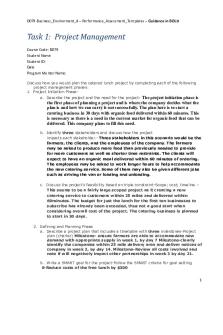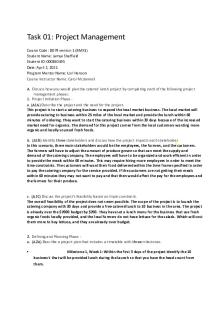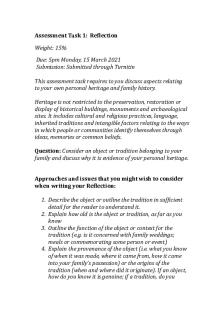Qht1 task 1 - Task 1 PDF

| Title | Qht1 task 1 - Task 1 |
|---|---|
| Course | Business Management Tasks |
| Institution | Western Governors University |
| Pages | 3 |
| File Size | 70 KB |
| File Type | |
| Total Downloads | 10 |
| Total Views | 174 |
Summary
Task 1...
Description
Widget Inc. Re: Cost of Quality for Widget 2.0 As we end fiscal quarter 3 of this year, I wanted to reach out and discuss our costs of quality for the new Widget 2.0 that we produce. There are three types of costs when quality considerations are made. The first cost that we incur is known as the appraisal cost. These costs go into our entire process of manufacturing the Widget 2.0; related costs are: parts, servicing, evaluating, measuring, and auditing materials to ensure the performs adhere to our quality standards. An example of an appraisal cost is the inspection equipment used to make sure Widget 2.0 is serviceable. Another example are the inspectors and labs that are used when evaluating the Widget 2.0. A possible trade-off is to hire two more inspectors. This would decrease the time in which the product is being evaluated for quality. Although the cost of hiring two more inspectors would increase payroll, it would decrease QC processing time, ensure better focus on each Widget, and increase the volume of Widgets that we can deliver to our customers. The second cost that we incur is known as the internal failure cost. These costs are all lumped into defective products before they are sold to the customer. Some examples of internal failure costs would be the sum of any reworks that need to be done on failed components, any material that is damaged or scrapped, and the loss in labor ours to rework the product in order to bring it up to quality standards. I believe we should buy more expensive components for our Widget manufacturing. The cost of materials would slightly increase, and our sales price would need to increase by 5%. However, the trade-off here is the decrease in reworking components. This would not only limit our internal failure costs, but also our external. The final cost that we incur is external failure costs. These costs are absorbed when our product is delivered to the customer and the product is found to have defects that don’t uphold our quality standards. Some examples of external failure costs are the sum of all Widget 2.0’s that are returned from the customer,
any costs associated with fixing the product, refunds, and liability claims from the customer. As mentioned above, procuring better components that would limit our internal failure cost exposure would also limit our external failure costs. The single trade off higher quality parts with an increase in price would limit our external failure costs greatly. This will save us substantial future costs.
References
Stevenson, W. J. (2018). Operations management. New York, NY: McGraw-Hill Education....
Similar Free PDFs

Qht1 task 1 - Task 1
- 3 Pages

QHT1 Task 2 - Task 2
- 1 Pages

QHT1- Task 3 - Assignment
- 2 Pages

PCE Task 1 - Task 1
- 2 Pages

Task 1 - SUS101 Task 1
- 2 Pages

QBM1 Task 1 - Task 1
- 5 Pages

C365 - Task 1 - Task 1
- 4 Pages

Task 1 - C226 Task 1
- 11 Pages

C304 Task 1 - TASK 1
- 16 Pages

DIT1 TASK 1 - Task 1
- 4 Pages

D078 Task 1 - task 1
- 2 Pages

Task d079 copy - Task 1
- 3 Pages

HMc Daniel Task 1 - Task 1
- 9 Pages
Popular Institutions
- Tinajero National High School - Annex
- Politeknik Caltex Riau
- Yokohama City University
- SGT University
- University of Al-Qadisiyah
- Divine Word College of Vigan
- Techniek College Rotterdam
- Universidade de Santiago
- Universiti Teknologi MARA Cawangan Johor Kampus Pasir Gudang
- Poltekkes Kemenkes Yogyakarta
- Baguio City National High School
- Colegio san marcos
- preparatoria uno
- Centro de Bachillerato Tecnológico Industrial y de Servicios No. 107
- Dalian Maritime University
- Quang Trung Secondary School
- Colegio Tecnológico en Informática
- Corporación Regional de Educación Superior
- Grupo CEDVA
- Dar Al Uloom University
- Centro de Estudios Preuniversitarios de la Universidad Nacional de Ingeniería
- 上智大学
- Aakash International School, Nuna Majara
- San Felipe Neri Catholic School
- Kang Chiao International School - New Taipei City
- Misamis Occidental National High School
- Institución Educativa Escuela Normal Juan Ladrilleros
- Kolehiyo ng Pantukan
- Batanes State College
- Instituto Continental
- Sekolah Menengah Kejuruan Kesehatan Kaltara (Tarakan)
- Colegio de La Inmaculada Concepcion - Cebu


